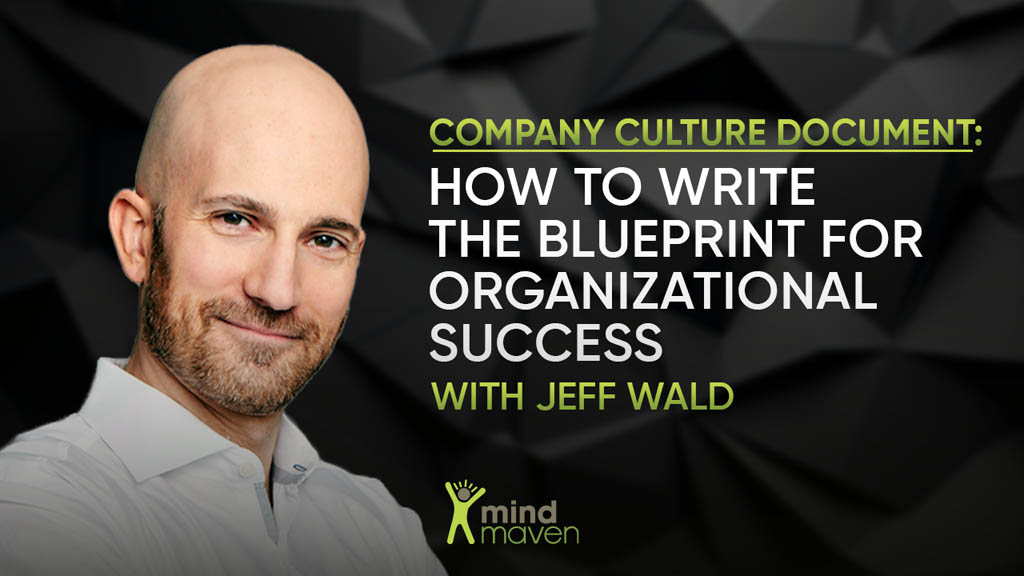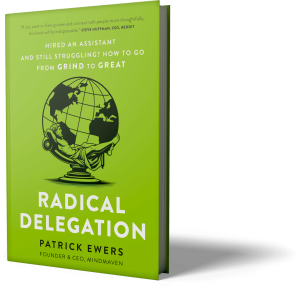The company culture document. You may have heard of it; you may even already have one …
But like most startups, you may be one of many who fail to make it come alive daily.
Providing the pragmatic insights you need to succeed, Mindmaven Founder and CEO Patrick Ewers is joined by Jeff Wald.
Jeff is the founder of several technology startups, including Bento Engine, Independetly.ai, Heist, Memory Lane, Sonero, and Spinback – a social sharing platform purchased by Salesforce.
With another HR tech startup on the horizon, Jeff is the prototype of a successful serial entrepreneur.
Together, they reveal the transformative power of a well-implemented company culture document for creating alignment that gets the team and the results you deserve.
Keep reading to learn the practical steps to create a living company culture document that enhances team cohesion and propels your operations toward achieving your collective North Star.
How Can Leaders Align Actions With Values?
Human First Leadership is an approach that prioritizes each team member’s well-being, personal growth, and empowerment.
Believing that a company’s success is built on genuinely valuing and investing in its people, Patrick asks Jeff why he considers forming a company culture document so critical to his organizational achievements.
Jeff: “We all talk about our people are our most important asset. Okay, I’m certainly going to be in violent agreement with that statement.
How are you aligning your people toward your goals?
How are you making sure these most important assets are being as productive as possible and are all thinking and doing the same thing broadly?
I would say the culture document is the thing that should be driving that.
This notion of who we are, why we’re here, our mission statement, where we’re going, our North Star, and our values.
And more important than just the values: The policies and procedures that support those values.
This is how we’re gonna show up.”
The Importance of Clarity in Company Culture
In 2018, Jeff’s company WorkMarket, an enterprise software platform enabling companies to manage freelancers, was acquired by ADP.
Jeff went on to serve on the Senior Leadership Team until 2020. During this time, Jeff experienced how a lack of clarity led to a pivotal shift in organizational culture post-ADP acquisition.
Jeff: “When I think about WorkMarket – and we had a wonderful exit to our friends at ADP – but I think about the 10,000 mistakes I made building that company.
This, to me, is number one …
It came to life for me during ADP’s diligence because ADP is one of the largest companies on the planet. They’re gonna have a thousand people doing diligence, and they were amazing.
But at one point, someone handed me a document. They had interviewed all our employees, we had several hundred, and it was 72 different answers to the question:
‘What does WorkMarket do?’
My own team did not understand. I thought they did.
I certainly had an answer to that question. But I was not clear, I was not intentional, I had not written it down.
It was a kick in the gut, and when you get those kicks in the gut, you go, ‘All right, I made a mistake. How do I fix it?’
WorkMarket’s First Company Culture Document
Outlining his proactive approach to rectifying these issues, Jeff prioritized clarity by actively involving his team in creating WorkMarket’s inaugural company culture document.
Jeff: “At the time, we had four different offices. I went to each of the offices, and I said:
‘This is who I think we are, this is what I think our mission is, this is what I think our North Star is, here’s what I believe our values are, and here are the policies and procedures I’ve put in place to support those.
But what do you all think? Because it doesn’t matter what I think. It matters what the hundreds of you think, and we collectively have to agree.’
That became WorkMarket’s first culture document post-acquisition by ADP.
As I’ve started this new company, the first thing I did was create a culture document – and those are living, breathing documents.
They’ve got to constantly change and evolve because as you add more people, the culture does change. It doesn’t change tremendously, but it moves on the margin.
We revisit that culture document every quarter:
- Who we are
- Why we’re here
- Where we’re going
- What we stand for
What Is a Company Culture Document?
Already, we’ve unpacked the importance of a company culture document, but what exactly goes into creating one? And if you’re just starting out, what’s the best piece of advice to get you on the right track?
Jeff shares his insights: “To me, it’s a 10-12 PowerPoint slide. For us, it’s a Google Doc because we don’t use PowerPoint.
When we come out of stealth, it’ll be up on our website; you will click on it, you can see the whole thing. Any one of your listeners that wants an example, I’m happy to send it to them.
It is not a complicated thing, but it is something that needs to be shared.
We start every team meeting here with that first page of the culture document: Who we are, why we’re here, and where we’re going.
Because I’ll tell you this, when your team says, ‘Gosh, you know, Jeff, I’m sick of hearing this.’
As soon as you hear that, you’re halfway there. Halfway to getting people to really internalize it.”
When Do You Need a Company Culture Document?
Creating a company culture document is the best way to cement in no uncertain terms who you are as a business, your mission, North Star, values, and the policies and procedures in place to support them.
But when is the right time to create a company culture document?
Jeff explains: “Right now, I’ve got 16 people on this team. It would probably be okay if we didn’t have a culture doc.
But when you get to that point where your organization has grown, and you walk down the hallway, and you go:
‘Who’s that guy?’
‘Oh, that’s a new engineer. We hired him three weeks ago.’
If you don’t have a culture doc by then, you’re in trouble. Because you have people going left when you think everyone’s going right, and you don’t have your whole team rowing in the same direction towards that North Star.
I’m not going to say you’re not going to be successful …
But isn’t your probability of being successful higher if everybody knows why we’re here, where we’re going, and everybody’s rowing in the same direction? Of course, it is.”
How To Address Systemic Issues in Company Culture
Systemic issues in company culture can throw a wrench in the works, leading to inconsistencies and misunderstandings.
So, how do you get your entire team singing from the same hymn book?
Jeff shares a real-life example of how a well-crafted culture document can help address these challenges and ensure everyone is aligned with the company’s core values.
Jeff: “I remember going to sales meetings, and if I show up to the sales meeting, the founders here, I’m going to do all the talking.
I was like, ‘No, you take it and run with it. I’ll just be here to answer questions.’
I was listening to how they were pitching the company, and I’m like, we don’t do that.
I had a conversation with that particular individual after, and I was like, ‘You said we were a marketplace, but we’re building enterprise software. The marketplace is just a feature, and it’s not really that good a feature. So it’s not a great idea to put it front and center.
He said, ‘But you called the company WorkMarket when you found it.’
I was like, ‘Okay, yeah, add that to the list of mistakes I made.’ And so we course-corrected that one individual.
I didn’t think I had a systemic issue. I did.
Fast forward, post culture document, and I would go to sales meetings, and I was now much more confident.
‘Hey, you lead!’ And they were all singing from the same hymn book. Here’s who we are – and they would say that same sentence.
I can promise you this … at this new company, if you go ask any of our 16 employees, what does the company do? They will say the exact same sentence.
You will say, what do you hope to achieve in three years? They will say the exact same set of KPIs.
Does it mean we’re going to be successful? Of course not.
If we didn’t do it, could we be successful? Of course, we could.
It just increases the probability of being successful if everybody is rowing in the same direction.”
Stay Tuned for Part 2 – Why a Culture Document Is Key To Building Successful Teams
We’ve only just begun to explore the profound impact a well-crafted company culture document can have on your business.
In Part 2, we’ll dive deeper with Patrick and Jeff into how creating a company culture document can help you build more productive, aligned, and successful teams.
Can’t wait to start enhancing communication and transparency within your business?
Get free access to our How I Work Notion Template now to begin setting the stage for improved productivity and collaboration.
Stay with us as we continue this insightful discussion with Jeff in the next installment of our series!


